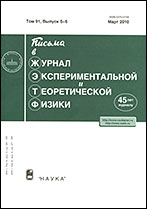|
|
Pis'ma v Zhurnal Èksperimental'noi i Teoreticheskoi Fiziki, 2008, Volume 87, Issue 8, Pages 491–496
(Mi jetpl90)
|
 |
|
 |
This article is cited in 55 scientific papers (total in 55 papers)
CONDENSED MATTER
New mechanism of the formation of the nanorelief on a surface irradiated by a femtosecond laser pulse
V. V. Zhakhovskiiab, N. A. Inogamovc, K. Nishiharaa
a Institute of Laser Engineering, Osaka University, 565-0871 Suita, Osaka, Japan
b Joint Institute for High Temperatures, Russian Academy of Sciences, ul. Izhorskaya 13/19, Moscow, 125412, Russia
c Landau Institute for Theoretical Physics, Russian Academy of Sciences, Chernogolovka, Moscow region, 142432, Russia
Abstract:
The kinetics of fast processes induced by an ultrashort laser pulse is considered. The reliefs remaining after the action of a series of ultrashort laser pulses {S. A. Akhmanov, V. I. Emelyanov, N. I. Koroteev, et al., Usp. Fiz. Nauk 147, 675 (1985) [Sov. Phys. Usp. 28, 1084 (1985)]; F. Costache, S. Kouteva-Arguirova, and J. Reif, Appl. Phys. A 79, 1429 (2004)} have been studied. A new mechanism of perturbing the surface of the initially ideal crystal face is described. First, the formation of a relief is induced by a single pulse. Second, the relief scale along the target surface is about the heating depth d T ~ 10–100 nm rather than the pump-pulse wavelength λpump ~ 1 μm. Third, the formation of the relief is not attributed to the modulation of the electromagnetic field near the surface due to the interference of the incident light wave with the electromagnetic surface waves on the initial perturbations of the boundary. These three conditions are satisfied for a known instability induced by the interference of the incident and surface waves (see the works cited above [1]). In our case, the nanorelief is formed due to the deformation of the spalled layer by cavitation bubbles owing to the inhomogeneity of the drag force in the target plane. Cavitation is caused by the tension of the substance in the process of the expansion of a heated target. It is similar to the known phenomenon of the cavitation “spallation” in a liquid despite the large difference between the space-time scales of the usual spallation facility and the femtosecond heating. Owing to this difference, usual cavitation does not leave any morphological trace on the outer free surface of the spalled layer.
Received: 11.03.2008
Citation:
V. V. Zhakhovskii, N. A. Inogamov, K. Nishihara, “New mechanism of the formation of the nanorelief on a surface irradiated by a femtosecond laser pulse”, Pis'ma v Zh. Èksper. Teoret. Fiz., 87:8 (2008), 491–496; JETP Letters, 87:8 (2008), 423–427
Linking options:
https://www.mathnet.ru/eng/jetpl90 https://www.mathnet.ru/eng/jetpl/v87/i8/p491
|


| Statistics & downloads: |
| Abstract page: | 291 | | Full-text PDF : | 131 | | References: | 51 |
|





 Contact us:
Contact us: Terms of Use
Terms of Use
 Registration to the website
Registration to the website Logotypes
Logotypes









